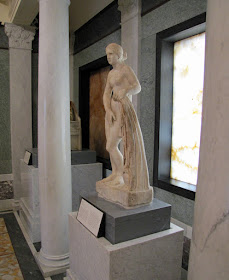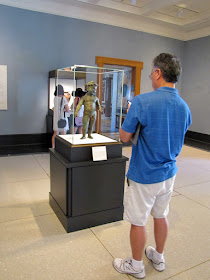We spent our anniversary this year at the Hotel Del Coronado. As luck would have it, they randomly assigned us to room 3333 on our 33rd anniversary. How strange is that? It was a sure sign it was going to be a great night.
We dropped our luggage off at the room and went downstairs for a drink.
This is the view from our seat in the lounge.
About a half hour later, these gentlemen arrived. After watching many photos being taken and studying the poster they laid by the table, we figured out that the black gentleman is Blake Leeper, the famous Paralympic athlete born without feet. That is one of his artificial feet that the man is holding at the table.
Disney is making a movie (or a special I can't tell which) about him called American Blade Runner. The poster about it is partially visible in front of the table.
We then stepped outside for a breath of the ocean air.
It was a gorgeous afternoon.
Looking back at the Hotel Del Coronado.
Time for our reservations at Sheerwater Restaurant, between the Hotel Del and the beach.
She had the Filet Minon, I had the surf-n-turf (Filet Minon and Lobster). Excellent!
We didn't know it until we were in the lounge, but there is now a Laugh Factory in the Hotel Del. We bought front row seats.
Tonight's comedians: Paul Rodriguez and Quinn Dahle.
So what did our room in the Victorian building look like?
Sunday, August 30, 2015
Vacation 2015 - Getty Villa : Arrival
This summer, we took a simple, quick trip to central California for a few days. We started in Malibu, at the Getty Villa.
NOTE: If you decide to go to the Getty Villa, GET TICKETS IN ADVANCE. Parking is very limited, so they only let you tour the Getty Villa if you sign up for a specific time in advance. Admittance is free, but parking is $15.
Exiting the parking garage, the first thing encountered is this map of the layout. Since we just drove up from San Diego and it is lunch time, we found the cafeteria on the map and had lunch.
For a Friday at noon, the cafeteria was fairly empty. The food is good.
Here is my wife once we walked downstairs to the Villa entrance. Ready to go in?
NOTE: If you decide to go to the Getty Villa, GET TICKETS IN ADVANCE. Parking is very limited, so they only let you tour the Getty Villa if you sign up for a specific time in advance. Admittance is free, but parking is $15.
Exiting the parking garage, the first thing encountered is this map of the layout. Since we just drove up from San Diego and it is lunch time, we found the cafeteria on the map and had lunch.
For a Friday at noon, the cafeteria was fairly empty. The food is good.
Here is my wife once we walked downstairs to the Villa entrance. Ready to go in?
Vacation 2015 - Getty Villa : Downstairs
The Getty Villa is a recreation of the Villa dei Papiri, a villa in Herculaneum, Italy that was covered during the eruption of Mount Vesuvius in 79 AD. Part of the city has been excavated, including part of the Villa dei Papiri. Since not all of the villa has been excavated yet, the Getty Villa is not an exact replica. The Getty Villa was built in the 1970s to hold the Roman artifacts collected by the Gettys and put them on display for the public.
This is the view upon first entering the Getty Villa.
Bronze Roman theatrical statue of a comic actor,
Another bronze Roman theatrical statue of a comic in full costume.
Sarcophagus with scenes of Bacchus. 210-220 AD, Rome. The inscription on the lid: "To the soul of the deceased. For Maconiana Severiana, the sweetest daughter, Marcus Sempronius Faustinianus, vir clarissimus [holding a senatorial rank], and Praecilia Severiana, clarissima femina [from a senatorial family], her parents [had this made]. The sarcophagus is small, so she must have died before adulthood.
Wine cup with crouching Satyr. About 480 BC, Greek made in Athens. Terracota. Artist was Makron the painter. More of his work survives than any other vase painter from the fifth century BC.
Comedy masks. Greek, 300-200 BC. Terracotta and pigment.
Roundel with a Comic Mask. 300 BC, Greek from south Italy. Bronze.
They had a number of displays showing Greek, Roman, and Etruscan timelines and how they related to each other.
Sarcophagus with scenes from the Life of Achilles. 180-220 AD, Attica, Greece. Faces were left unfinished so that purchaser of coffin could have their faces carved.
The Landsdowne Herakles. 125 AD, Roman. Marble. This was one of J. Paul Getty's most prized possessions - it inspired him to build the museum in the style of an ancient Roman villa. Shortly after its discovery in 1790, the statue was reworked by a Rome restorer. It was stripped of the restorations in the 1970s, but the additions reintegrated in the 1990s.
Zeus. About 100 BC, Greek. Marble. This statue was submerged in the sea for a considerable amount of time. The well-preserved portion was buried in sand.
Muse. 200 AD, Roman. Marble, pigment, gold. Particles of gold leaf remain in her hair, which was originally fully gilded.
Venus. 175-200 AD. Roman. Marble and pigment.
The Hall of Colored Marbles emulates luxurious rooms that served as status symbols in the Roman Imperial period. Romans used a wide variety of marbles imported from distant lands. The patterns in this hall were inspired by those found in Pompeii and Herculaneum.
Bull statue. 100 BC - 79 AD. Roman. Silver and gold.
Fertility goddess statuette. 600-575 BC. Greek, made in Boiotia. Terracotta.
Mixing vessel. 390-350 BC. Athens, Greece. Terracotta.
Vessel with Leda and the Swan. 330 BC. Greek, made in Apulia, South Italy. Terracotta.
Mixing Vessel with Apollo and Artemis. 415-400 BC. Greek, made in Lucania, South Italy. Terracotta.
Statuette of Venus. 100-300 AD. Roman. Silver and gold.
Young boy. 1-50 AD. Roman. Bronze, silver and copper. Marks on the shoulder blades suggest that wings were once attached.
Statuette of Poseidon. 120-100 BC. Greek, made in eastern Mediterranean. Bronze.
This is the view upon first entering the Getty Villa.
Bronze Roman theatrical statue of a comic actor,
Another bronze Roman theatrical statue of a comic in full costume.
Sarcophagus with scenes of Bacchus. 210-220 AD, Rome. The inscription on the lid: "To the soul of the deceased. For Maconiana Severiana, the sweetest daughter, Marcus Sempronius Faustinianus, vir clarissimus [holding a senatorial rank], and Praecilia Severiana, clarissima femina [from a senatorial family], her parents [had this made]. The sarcophagus is small, so she must have died before adulthood.
Wine cup with crouching Satyr. About 480 BC, Greek made in Athens. Terracota. Artist was Makron the painter. More of his work survives than any other vase painter from the fifth century BC.
Comedy masks. Greek, 300-200 BC. Terracotta and pigment.
Roundel with a Comic Mask. 300 BC, Greek from south Italy. Bronze.
They had a number of displays showing Greek, Roman, and Etruscan timelines and how they related to each other.
Sarcophagus with scenes from the Life of Achilles. 180-220 AD, Attica, Greece. Faces were left unfinished so that purchaser of coffin could have their faces carved.
The Landsdowne Herakles. 125 AD, Roman. Marble. This was one of J. Paul Getty's most prized possessions - it inspired him to build the museum in the style of an ancient Roman villa. Shortly after its discovery in 1790, the statue was reworked by a Rome restorer. It was stripped of the restorations in the 1970s, but the additions reintegrated in the 1990s.
Zeus. About 100 BC, Greek. Marble. This statue was submerged in the sea for a considerable amount of time. The well-preserved portion was buried in sand.
Muse. 200 AD, Roman. Marble, pigment, gold. Particles of gold leaf remain in her hair, which was originally fully gilded.
Venus. 175-200 AD. Roman. Marble and pigment.
The Hall of Colored Marbles emulates luxurious rooms that served as status symbols in the Roman Imperial period. Romans used a wide variety of marbles imported from distant lands. The patterns in this hall were inspired by those found in Pompeii and Herculaneum.
Bull statue. 100 BC - 79 AD. Roman. Silver and gold.
Fertility goddess statuette. 600-575 BC. Greek, made in Boiotia. Terracotta.
Mixing vessel. 390-350 BC. Athens, Greece. Terracotta.
Vessel with Leda and the Swan. 330 BC. Greek, made in Apulia, South Italy. Terracotta.
Mixing Vessel with Apollo and Artemis. 415-400 BC. Greek, made in Lucania, South Italy. Terracotta.
Statuette of Venus. 100-300 AD. Roman. Silver and gold.
Young boy. 1-50 AD. Roman. Bronze, silver and copper. Marks on the shoulder blades suggest that wings were once attached.
Statuette of Poseidon. 120-100 BC. Greek, made in eastern Mediterranean. Bronze.
























































